|
FAQs about Sea Urchins, Sand Dollar
Identification 2
Related Articles: Sea
Urchins,
Related FAQs: Urchins 1,
Urchins 2 , Urchins 3,
Urchin
Identification 1, Urchin ID 3,
Urchin ID 4,
Urchin Behavior, Urchin Compatibility, Urchin Selection, Urchin System, Urchin Feeding, Urchin Disease, Urchin Reproduction,
|
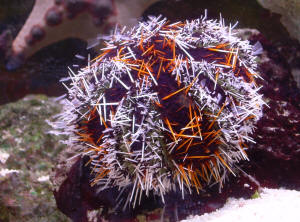
|
Question about urchin 12/7/11
To whom it may concern,
<Hi there>
I was told about an urchin that is from the Pacific
Ocean that is known to devour coralline algae.
<There are several, from the M.E. meaning
"many">
I was told it is called an impact urchin.
<"What's in a name?" BillyS>
I believe they are purple in color. Is that the correct name?
<Common names are always correct Johnny>
If not what is the correct name and what is the scientific name? Look
forward to your response.
Christopher Faiola
<Me too. Let's see... I'll use Google... "impact urchin
pacific eating coralline"... Oh! The fourth listing... on WWM, try
this. Bob Fenner>
Re: Question about urchin 12/7/11
So where is the answer at? I don't know what you mean by fourth
listing on WetWebMedia.com
<Mmm, sorry re the lack of clarity. The fourth listing on Google,
given the search string I supplied. I don't know what an
"impact urchin" is... BobF>
Checking in... Urchin ID to file... diving,
spearing Pterois 7/21/11
Bob,
It has been awhile since I talked to you but I was doing some research
around the site this evening and figured I would drop a line. Just
wanted to mention you guys are still doing a wonderful job and keep it
up. You do not get paid half of what you should… ;-)
>Half of zip?<
Firstly so that you can be proud and pleased, although I have no expectation for
you to remember me or my questions from months ago, taking your advice on
lighting I have upgraded, in a 50Gal, to a 36 4 bulb HO T-5 lighting retro kit from the PC
bulbs. I have installed a bulb from each color spectrum and the entire
look of the tank has completely changed. Everything is colorful, and
growing almost too rapidly now. =)
<Ah good>
One quick question if you get to it, no pressing matter…
today I bought what the LFS called a Royal Colored Urchin. Some
research on your site makes me think that is a misnomer and it is in
fact a Tripneustes gratilla, which is in fact a Pin-cushion Urchin and
not a Royal Urchin?
<What's in a (common) name? You can call it/him Ray, you can
call him Jay>
I do not expect you to know what it is without me sending a picture; I
would just like to know if these ARE in fact two different creatures
that look similar, or if I was just misinformed. Thanks.
<Can't tell from here... sans pic>
Also, and the real reason I wrote in: About a month ago we dived
(learned that from you! Lol) down in Pompano and took part in
aÂ… I guess the only thing to call it is a full party
spearfishing hunt for Lion Fish. I cannot believe how many there are
taking over down there. I dread the thought but I have heard they are
also becoming rampant in the Keys where I will be heading in about 2
weeks. Anyways, just wondering if you were taking part in any of that
and if so when are you going to be diving?
<Have shot a few Pteroines in my time... including in the tropical
West Atlantic. Luckily they're tasty>
The wife and I would love to come join up for a day. Thanks again for
all you guys do.
JM
<Thank you for your upbeat message, sharing Justin. Am in San Diego
most the time; but maybe you two will join friends and I out for a bit
of dive-travel adventure? Bob Fenner>
Re: Checking in, Echinoid ID -- 07/21/11
Yes half of zip, hence the joke and why it was half funny. =) We are
going out to San Fran this summer after we get back from the Keys... it
is a long trip but maybe we will have time to ride to San Diego and
have a dive tour from the locals.
<Ahh! What day/s will these be? Perhaps I can help you w/ your
itinerary here, by making suggestions of what you might visit,
do>
I know you could not identify the urchin without a picture, but I
suppose that was really my question - is it just a common name
difference or do two separate creatures out there of the urchin variety
that would look this similar actually exist?
<Again... there are "stock" or standard if you will,
common names for most all used species... Hopefully only one scientific
one! Do send your pix along>
, not which mine was. Also, I did not previously know the proper name
for Pteroines, thanks for that.
<Again... wanting to be clear/er>
Have a great summer.
JM
<Ahh, am doing so. You and yours as well. Cheers, BobF>
Justin Morton
|
Urchin ID: Echinometra spp. - 3/30/11
Hi crew,
<Hi, Lynn here today.>
..could you please ID this urchin for me? I am interested in
buying it and use it for algae control. The fish store has it
labeled as a common urchin. It looks like the Echinometra mathaei
on your website but I am not certain. Is this correct?
<It depends on where the urchin is from. If it's from the
Indo-Pacific area, it's probably Echinometra mathaei; if
it's from the more tropical areas of the Atlantic, it
probably Echinometra viridis. Both are primarily herbivores, but
may also consume 'meatier' items on occasion, including
sessile invertebrates like sponges and soft coral tissue. Perhaps
the urchins consume these latter items when their favored food is
running low; I just don't know. I can tell you though that I
had an E. viridis in a tank with all sorts of corals for several
years and never had any problems. It came out at night, grazed,
then returned to its preferred crevice in the rockwork each
morning. One thing to keep in mind with urchins in general is
their tendency to bulldoze items/rearrange aquascapes as they
gain in size. Please see the following link for more photos/info:
http://www.wetwebmedia.com/urchinsii.htm?h=
Be sure to also enter each species name into our Google search
engine for related FAQ's: http://www.wetwebmedia.com/Googlesearch.htm
>
Thanks
<You're very welcome. Take care, Lynn Z>
|
|
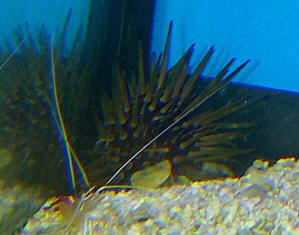
|
|
Identification of sea urchin -- 12/20/10
Dear Bob Fenner
<Raju>
Can you identify the sea urchins photos attached. This was
photographed in West coast of India.
thank you
<Mmm... the second may be Diadema savignyi... Do you have
other/better resolved pix of the first? Bob Fenner>
Raju
Karnataka
India
|
|
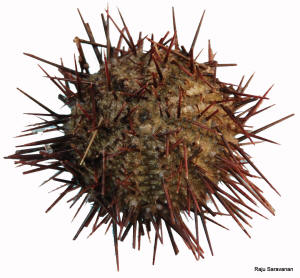 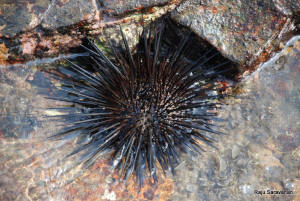
|
|
thank you -Sea urchin ID 12/21/10
Thank you Bob Fenner,
I will send it by nest week after my collection trip for better
photographs.
thank you
Raju Saravanan Scientist
Marine Biodiversity Division
Mangalore Research Centre of CMFRI
Karnataka
India
Thank you Raju. BobF
|
|
Names: Salmacis spp. Urchin and Likely Asterina Stars
-- 10/4/10
Hi
<Hello, Lynn here today.>
Please advise what the name of the urchin and small sea stars
are.
<The urchin looks like something in the genus Salmacis,
possibly S. bicolor (family Temnopleuridae). As for the stars,
all but the bluish individual look like Asterinids (family
Asterinidae). I can't see the bluish one's shape/surface
texture well enough to determine whether it's another
Asterinid or something else entirely (like a cushion star, family
Oreasteridae). Either way, I wouldn't trust any of these
stars around corals. For more information on sea stars, please
see the following link: http://www.wetwebmedia.com/seastars.htm
Urchins: http://www.wetwebmedia.com/urchins.htm
>
Thanks
<You're welcome. Take care, Lynn Z>
|
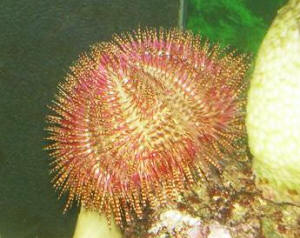 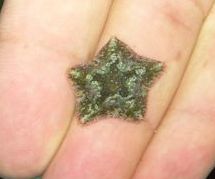 |
|
Urchin ID please (RMF, dissension) <None> --
04/12/09
Can someone please identify this urchin? thanks
<It's a spatangoid urchin, what sometimes get called heart
or potato urchins. They're infaunal animals that feed on the
meiofauna and to a certain degree organic detritus. If you look
closely, you'll see that it's
oval rather than circular, and unlike above-the-ground sea
urchins, these burrowing urchins have a definite front and back.
They plough through the sediment, feeding on the tiny (sub-1 mm)
animals they find there. Given they need a deep, meiofauna-rich
sediment to feed in, they can't be kept in aquaria and
moreover if they're happy, you won't see them, since they
live several centimetres under the surface of the sand. Even in
marine research labs we had trouble keeping these things alive
for any length of time. Bob may have a different
experience/opinion, but my advice would be not to waste your
money buying the thing, and certainly not to encourage retailers
to order them in by doing so. Cheers, Neale.> <<I concur
Neale. RMF>>
|
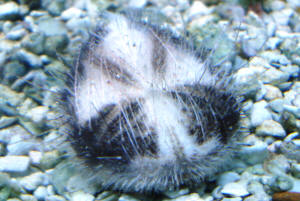 |
|
Hitchhikers: What is this???: It is an urchin
4/11/2009
<Hi Sherry>
See attached pic.
<Seen it>
I found this in my tank and have no idea what it is. Can you help
me?
<Sure.>
Looks like some kind of urchin...not sure.
<It is an urchin. Looks like Eucidaris tribuloides or Pencil
urchin. See here for identification and the linked pages at the
top for care and feeding:
http://www.wetwebmedia.com/urchinsii.htm
>
Thanks
<No problem>
Sherry
<Mike>
|
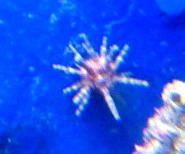 |
|
Sea Urchin ID 2/2/09 Hiya Fellas! <Hello
Joey> Good to talk to you guys again! I was looking thought
the Urchin ID threads and I saw the picture attached. I have a
little guy just like this in my tank and I'm wondering what
he is? Collector Urchin looks to be it but since it seems there
are several different flavors of these little dudes I want to
make sure. He has the same color strips and all just like this
quite little fella! <Likely a Tripneutes gratilla, a Globe
Urchin.> Thanks guys! <You're welcome. James (Salty
Dog)>
Joey
|
 |
|
Re: unknown hitchhiker
2/1/09 I apologize I sent the wrong photo. I will attach
the correct photo. sorry again, Anna <Mmh... looks like a type
plastic needles used by the hobbyist or shop to fix the
Clavulariid. Will leave this email for other crew members to see
and have a guess. Marco.>
|
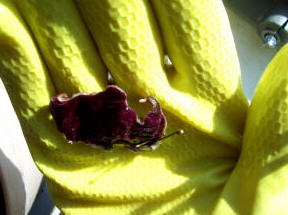
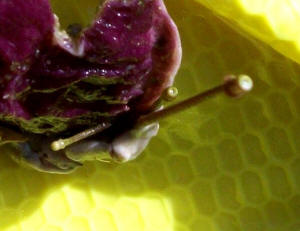 |
| Re: unknown hitchhiker 2/1/09
I apologize I sent the wrong photo. I will attach the correct
photo. sorry again , Anna. <Me again, probably hit the send
button too early. Can you get them out, see if they are plastic? Do
the smaller ones have the exactly same length or are all 3
different? Some sea urchin spines look quite similar, compare
http://www.kreidefossilien.de/assets/images/galleries/182/pseudodiadema_sp_.jpg
. Cheers, Marco.> |
| Re: BobF asking... what is this?
2/2/09 Lynn... Howsit? Marco responded ayer to this person
re something in their tank, and they've sent along a new pic...
I can't put my finger on what these three prominences are
she's referring to... Can you? Have put in your in-folder.
BobF. Doing good this morning, Bob! I just checked out the photo.
You know what those look like - urchin spines - with the
attachments/bases visible on the ends and the tips buried in
whatever that thing is. -Lynn <D'oh! Of course! Maybe just
some BGA overgrowing... Thank you Lynn. BobF> You betcha!
I'm glad I was able to help. :-) Take care and have a great
week, -Lynn <Thanks Lynn. You as well. BobF> |
|
Unidentified Urchin! 11/13/08 Hi WWM,
There's an urchin at my LFS and no one really knows what it
is. The tag is a "Confetti Urchin" but I couldn't
find much about them. (In fact, there was nothing.) Could you
please tell me what it is and give me a little information
regarding it? <Mmm, almost certainly a Tripneustes species...
see here: http://wetwebmedia.com/urchinsii.htm> I attached a
picture to the e-mail. He's leaning on a rock so he's
sideways but you can clearly see it. It doesn't move a whole
lot and seems to like the same general region of the tank. I
thought this seemed a little odd as urchins are a bit more active
than that, but hey, no fish is the same as another! Thanks for
your help and good day. <If you know the ocean of origin...
should be easier to discern. Bob Fenner>
|
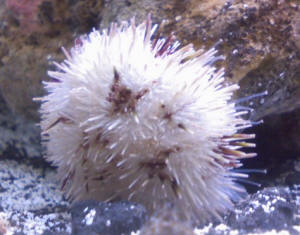 |
Distributors and species names: Regional variation.
Urchin sel. 6/13/08 Hello, WWM crew. <David> I am hoping that
with some of your people having experience with the distributors in the
Pacific that perhaps they will know something about this. I have been
trying to get an Astropyga radiata via my LFS, but the two times he has
ordered one (or three), what have arrived were Tripneustes gratilla.
The second time he even sent a picture of what we wanted. The two
species don't look that similar, so I'm left with wondering if
there is some common name that those in the eastern Indian Ocean /
western Pacific Ocean call this urchin, because the scientific name
isn't doing it. Any thoughts? <Mmm, yes... for one, the trade is
composed of "disparate players"... the actual
collectors/divers are not often in the employ of the folks who gather,
sell, ship livestock... So there is likely a disconnect here. Astropyga
are rarely "used" in the trade, owing mostly to their long
spininess... and difficulty in shipping there from... costing more to
put in larger bags, screened, with more water (shipping is more money
than livestock per se in most cases). Whereas Tripneustes are more
compact, easier, cheaper to ship... Both animals are not that rare in
the wild, easily collected. At any length, what I suspect is that these
two influences, the fact that you're not communicating with the
actual collector/s, and the social inertia of folks dealing with the
Tripneustes is working against you. I would keep sending the images,
asking whomever you're dealing with, to show same to their
source/collectors. Bob Fenner> Thanks in advance.
David
Urchin Identification Question: Likely Lytechinus
sp. 4/19/08 Hey WWM guys, <Hi Andy> First, let me commend
you all on your dedication to the people that love this
hobby/research/science so much. <You're very welcome and
thank you so much for writing us. WWM is a collaborative effort
-not just of Bob and the crew but everyone that writes in as well.
All have a part in furthering the knowledge base and in fact
helping one and all.> I tell everyone that gets into the hobby
that y'all are usually the best reference on anything marine.
<Heheee! Although I'm partial to anything marine, the other
sections are equally as good!> On to the question; my mom just
bought a new urchin from her LFS, pics attached, I am pretty sure
it is a color morph of the variegated urchin Lytechinus variegatus,
but just want to make sure it is not one of the toxic ones. Could
you help me out on identification?? <Oh boy, is it ever a pet
peeve of mine when sellers don't supply the species names of
the creatures they're selling. Even when they do however,
it's important that the hobbyist confirms it in order to
determine whether they will be able to properly care for the
animal. In this case, the urchin does appear to be in the family
Toxopneustidae, and I agree that it's likely in the genus
Lytechinus (and very likely L. variegatus). However it could be one
of several other genera/species as well within this family. With
closely related urchins, the best and sometimes only way to
differentiate requires studying the details of the test (shell of a
dead specimen). Without that, you're left comparing the color
of the spines, etc, which can vary widely and lead to incorrect
identification. Toxopneustidae includes a host of genera including
the aforementioned Lytechinus as well as others such as Tripneustes
and Toxopneustes that are toxic. I'd err on the side of caution
and avoid contact. Indeed I'd recommend this whenever dealing
with any spiked/spiny animal. For more information and photos,
please see the following links:
http://www.wetwebmedia.com/urchinsii.htm
http://www.nhm.ac.uk/research-curation/projects/echinoid-directory/taxa/gallery.jsp?parent=1188
http://www.coastalplanning.net/projects/broward_glass/broward_glass.html > Thanks for your time, Andy
<It was a pleasure, Andy. Take care, -Lynn> |
|
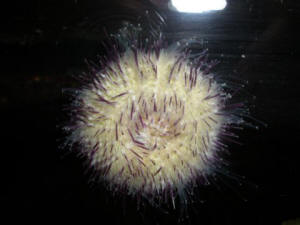 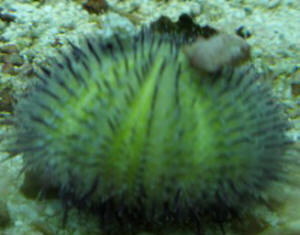
|
|
|

